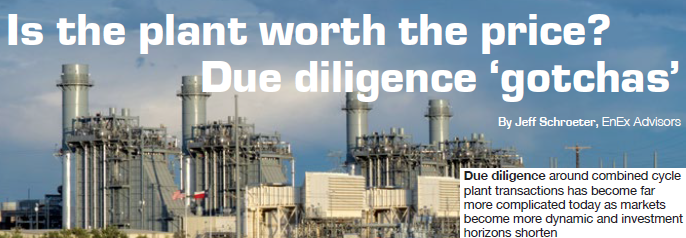By Jeff Schroeter, EnEx Advisors
 What does the legal term “due diligence” really mean? One thing is for sure: The diligence period before closing the sale means buyer beware, or caveat emptor. During this period, the buyer is entitled to research the true value of an asset from the buyer’s perspective.
What does the legal term “due diligence” really mean? One thing is for sure: The diligence period before closing the sale means buyer beware, or caveat emptor. During this period, the buyer is entitled to research the true value of an asset from the buyer’s perspective.
We all like to get a great deal. We all can get passionate about the new purchase. We’ve all shopped for a home or a car, and it’s easy to let our emotional side get the better of our rational side. We want to believe what the seller (or the agent) has told us, the crack in the wall is cosmetic, not structural, or the wheezing sound from the engine has been there since it was brand new.
But a $100+ million combined-cycle powerplant is not a used car, or even a house, though the same healthy skepticism should prevail. Typically, owners make only the bare minimum investments in an asset they plan to sell. Due diligence (DD) is the buyer’s opportunity to adjust the purchase price, or at least understand the risk factors, before money changes hands. But the dynamics of today’s power industry has made the DD period much more challenging.
Transactional industry
Powerplants change owners frequently. Many of these transactions are caused by the merchant nature of power markets like Ercot, CAISO, or PJM. Another reason is that private equity funds have very specific buy and hold horizons, often as short as six to 10 years. Many combined-cycles commissioned around the Y2K timeframe are now on their second or third owners, some on their fourth or fifth!
Many factors determine asset value: physical location within a power market (localized congestion value), a long-term power purchase agreement (less merchant risk of production revenue), long-term service agreement around major components (gas and steam turbines), and plant safety record. But other factors not as transparent to plant staff affect plant value as well—including fuel supply agreement and pending environmental restrictions. Buyers want to be assured of paying a fair market price for a flexible asset that can adjust to market changes.
Today, the DD assessment is complicated by a host of additional factors. Peaking gas-turbine plants are experiencing rising capacity factors because of the favorable prices and projections for natural gas. Combined cycles designed to displace coal back in the 1997-2003 time period were quickly relegated to low-capacity-factor duty as the price of natural gas shot up.
More recently, after gas prices moderated and compliance costs for coal ballooned, gas-fired combined-cycle capacity has been displacing baseload coal in many parts of the country. And grid operators are constantly introducing new rules and regulations to balance competitive market procurement of services with reliability of service.
Eight areas of concern
The DD period, often about 60-120 days, is an opportunity for a prospective buyer to review all asset records, contracts, permits, and legal commitments. DD team members should include engineers, attorneys, environmental scientists, project finance modelers, and investment bankers. This team’s only mission is, simply, to assure that the purchaser knows what he/she is buying, identify all risk factors, and adjust the asking price accordingly.
Today, your team should have specific and deep expertise in the following areas:
- The markets involved.
- The model series of equipment and its current condition, including repair cycles.
- The regulatory and compliance envelope the plant has to function within.
- Dynamic grid operations and financial models which account for hourly and even sub-hourly pricing and bid opportunities.
- O&M contracts, both from the legal and O&M perspectives.
- Fuel delivery and supply.
- Real estate and commercial issues.
- Insurance requirements.
- Staffing and training.
- Controls, monitoring, and diagnostics.
- Automation and knowledge management platforms prevalent at power stations.
Deferred maintenance, especially around the gas and steam turbines, probably is one of the largest and obvious areas of concern, but not necessarily easy to quantify. This is more of an issue in the merchant markets where long-term Power Purchase Agreements (PPAs) do not exist. In Ercot, for example, average term of thermal-plant sales contracts are about four to seven years. A 15-year-old project may have delayed major expenses which would mean the new owner would have to pay for them much sooner than expected.
A complicating factor in assessing deferred maintenance is the plethora of machines which have come off of their original OEM service agreements, the varied repair companies and repair techniques now being widely applied, and the changing operating regimes and owner/operators. Repair techniques are aligned with remaining life of the components and current operating duty. Some may not be fully proven.
In addition, while there may be maintenance records for review, the staff and owner may have relied heavily on outside expertise. Finding these experts and interviewing them, or hiring people for the DD team who can assess the work, may be difficult.
Reviewing remaining cyclic life of the equipment is also a key area for evaluation. Most fossil-fired powerplants constructed in the last 50 years were designed as baseload units. As markets shift or newer, more efficient plants enter service, the operating profile tends to change.
Two areas of concern are HRSG life and SCR/CO catalyst life, which naturally receive less attention than the primary turbine/generators. Repairs or replacements in these areas can be major items which must be planned for years in advance.
Real estate issues, such as the land title and environmental contamination, should be assessed for additional insurance against defects or unknown risks. These are important to mention because much of the DD work tends to be centered on the major equipment. If new debt is being placed on the project, the new owner must factor in the cost for changes to insurance premiums.
Spare equipment inventory is a major consideration. For example, does the plant have a spare boiler feed pump in its warehouse? What is the contingency plan to deal with a failure of a step up transformer? Generally, utility-owned plants carry more major equipment spares than merchant or IPP facilities. The old adage, “you don’t invest in something you’re planning to sell,” comes into play.
Asset management contracts are usually transitioned and then renegotiated with the new owner. Be sure that the transition process does not disrupt cash flow and opportunities for selling power on the grid, especially if in a merchant market. Similarly, O&M contracts are often under a five-year renewal cycle. Many members of the existing plant labor force will often be retained by the new contractor which may, however, bring in a new plant manager. Given the M&A activity with OEMs and service firms, sorting out these contracts will be anything but straightforward.
By contrast, Contractual Services Agreements (CSAs) often are not renegotiated and are just assumed by the new owner. This usually is a net positive for equipment availability but it can have a negative cost effect if the agreement was based on an obsolete operating regime. An example is an agreement that only allows × starts per year without expensive overage charges because that is what the unit was doing years ago. In the current market, the plant may need to start 2× times annually. The cost implications of a contract adjustment for the new owner could be a potential “drag” on profitability.
Energy delivery contracts often are renewed or renegotiated by the new owners. Major changes only would be warranted because of poor performance or excessive fees. However, participation in most ISO and RTO markets around the country only gets more complicated. Grid operators constantly struggle with ensuring reliability while opening up more grid services to greater competitive forces.
Transmission reservations with wires companies may have a huge effect on plant profitability if the plant now operates fewer hours. There are examples of this being a significant cost, particularly in the CAISO market. Also in this category are the various NERC and FERC reliability and cybersecurity compliance issues, which also only get more complicated year to year.
Depending on the state and market ISO/RTO, a return to a regulated power market for a plant with an expired PPA can significantly impair its value. In some markets, the buyer of last resort is the local utility which may not even want a contract with the plant. A corollary to this issue is when a gas-fired plant finds itself in a fast-growing renewable energy market. In this case, annual energy production may be far less than expected.
Fuel transportation contracts should be reviewed based on the expected operation envelope of the project. Some peaking projects may have significant annual transportation reservation charges or imbalance penalties which could affect bottom-line revenue. The new owner may decide to add a second gas connection to the plant to obtain a more competitive transportation deal.
Controls, automation, and knowledge management platform is a final area where DD assessment gaps are likely to persist. Digital and wireless technology is advancing rapidly—much more rapidly than the physical equipment. The wise buyer will pay as much attention to how the plant is, and will be, monitored and automated, and how data and knowledge are captured, disseminated, processed, and used in decision making; cybersecurity and grid security issues; and the interaction of staff with the automation and training platform. The fact is, today much less expertise actually resides at the plant, instead being dispersed throughout what some call the “meta-organization.”
Other broad areas for attention include environmental attributes and compliance with air, water, and solid-waste regulations; taxes, subsidies, and government incentives; and qualitative values such as community relations and labor relationships.
About the author
Jeff Schroeter has over 38 years as an IPP owner/developer/diligence advisor and is currently managing director of EnEx Advisors in Plano, Tex. He can be reached at jschroeter@enexadvisors.com.




